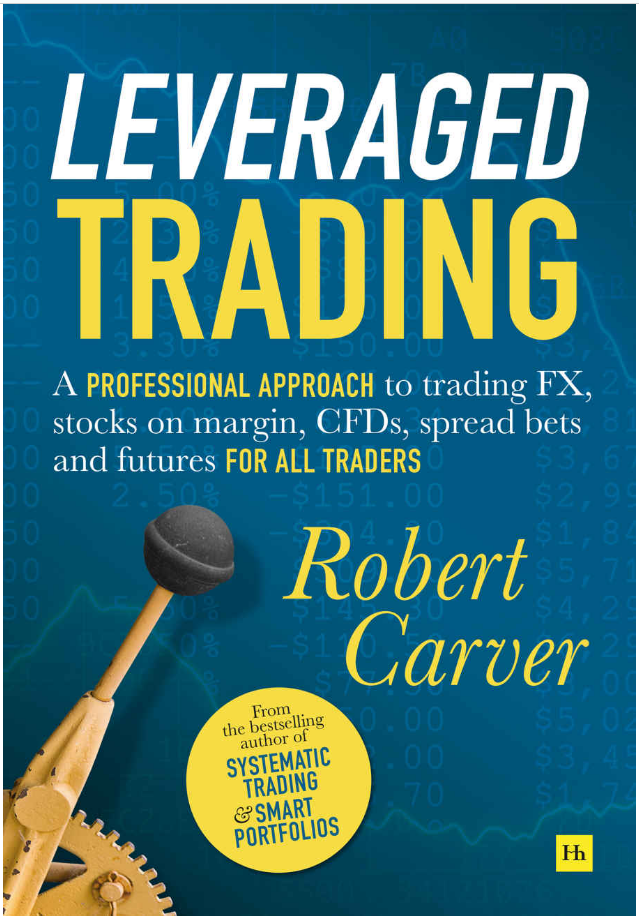I tend to be a little skeptical when I see books aimed at retail traders with low amount of trading capital, focusing on leveraged trading on FX, CFDs and the like. The very mention of retail forex trading means that there’s a near certainty that whatever comes next is misinformed at best and a scam at worst. But seeing my favorite investment author release a book on the topic got my attention.
I just received my copy of the new book Leveraged Trading, written by Rob Carver and I was not disappointed. I have written before about enjoying his past two books, Systematic Trading and Smart Portfolios. His latest book is not just the best coverage of the topic of leveraged trading of small portfolios I’ve read, it’s actually the only good one I’ve come across.
The prevailing attitudes in this part of trading tends to be based on marketing and misinformation trumpeted out by brokers, self proclaimed gurus and people who want to sell you ‘forex robots’. The gist of what you see most of the time is that you should only trade forex, as that is somehow cheap and easy to make money from, and that you should take take high risk, aiming for hundreds of percent a year.
There’s a reason somewhere around 80-90% of retail traders wipe out.
Rob’s book is a sobering approach, explaining in great detail how leveraged trading works and how it doesn’t. A part early on that I loved what an analysis of the true costs of trading various asset classes, debunking the usual claim of forex trading being so cheap. He has a great write-up early in the book on risk adjusted trading cost for various asset classes and the implications of those those numbers. This is something extremely important that most retail traders simply gloss over. After the fact, when their money is lost, they wonder what happened to their seemingly profitable trading strategy. Well, ignoring these actual costs tends to be a main part of the answer.
Based on these costs, he introduces the concept of Speed Limit on Trading. This is a great way of looking at the cost part of trading, and how much of your expected trading returns you can spend on costs. This is not something you usually see mentioned in retail trading books and it should be a sobering wake-up call for forex day traders who were not fully aware of the actual costs.
The book continues by building a complete trading model for leveraged trading of small accounts, explaining each part of it. As I very much appreciates, his focus is on the risk management side and on what kind of risk and return you can realistically achieve with such models and account sizes. His rules may seem simplistic at first glance, but pay attention to the details. It’s not as much about the exact buy and sell rules. The real magic is in the risk side. If you get that risk, the rest will follow.
In the later parts of the book, he gradually improves up on this model, showing methods of diversification and enhancements. He discusses advanced concepts around continuous trading, whether to use a stop, dynamic position sizing, non-binary trading and more.
If you are trading a smaller account, meaning anywhere from a couple of thousands to a couple of hundred thousand, I’d say that the knowledge in this book is absolutely vital.
With a large portfolio of millions of dollars, you can get trading costs down dramatically and easily achieve a high degree of diversification. That’s the realm where my own writing tends to focus. For private trading however, you do need to know this stuff.
Even if you have no interest at all in systematic trading, you will find an enormous value in understanding the cost and risk side of leveraged trading.
My exposure to the retail trading community is mostly through the conferences I speak at. Each conference is slightly different in terms of audience, but a general theme I’ve noticed is that attendees often lack sufficient understanding of risk and cost. That’s not overly surprising, as most people marketing products and services to this community have very little interest in highlighting such things.
It can sound a bit boring as well. The very terms risk and costs makes you think that someone is holding you back, trying to get you to do less, make less money. That’s not necessarily the case. While it can be the case that you should take less risk, it can also be a matter of that you should take different risk. That is, you might actually take too high risk on some things and too low on others. Most people I speak to in the retail trading world, even though making good money on it, still lack a proper understanding of the concepts of risk and they often are not fully aware of the true trading costs.
Rob’s book should clear a lot of that stuff up for you. He shows you that it is very much possible to trade smaller accounts on leverage and make good money, as long as you have reasonable expectations and understand what you’re doing.
Amazon Best Sellers Rank
Most people buy their books from Amazon these days. You can have all kinds of opinions about that, but it’s still a fact of life. There’s a number for any book on Amazon called the Amazon Best Sellers Rank which is probably only really understood by authors and publishers. You can see it on the product page for any book, under product details.
This number is a whack-a-mole game. The number will slowly creep up, higher and higher, if no sale is made. Whenever a sale is made, it gets knocked down a bit. If there’s a lot of sales made, it gets knocked down to a low number. If sales are continuing, the number stays low.
In the end, this is a number that’s very hard to understand unless you’re an author or a publisher, knowing the ongoing sales and comparing with your ABSR number.
Without knowing anything about Rob’s sale numbers, I do see something that bothers me. While his new book is selling well in his native UK, for some reason his number on Amazon.com is far too high. He’s not selling as much in the US as he rightfully should with such a great book. Perhaps due to lack of marketing across the Pond.
Well, here’s my little experiment. An overwhelming part of my own audience is in the United States. People all over the world will likely read this article, but a disproportionate amount of you are Americans and likely to do your shopping at Amazon.com. I know what his number is right now and I’m going to keep an eye on it after posting this article and see if I’m able to make a dent in it. Quite frankly, this book deserves to climb the best selling list.
This is a great book. Go buy it.
 Following the Trend
Following the Trend






